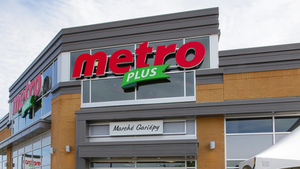TOURING A NEW NEIGHBORHOOD MARKET
Not long ago, SN joined a tour of several food-driven formats in Dallas, one of which was a Wal-Mart Neighborhood Market. That's the discounter's small food and pharmacy store.Take a look at the report , written by Barbara Murray, on page 35 and you'll see a great deal about how the store looks in Dallas, the price points offered and so on.One observation is that Wal-Mart seems to be dropping the
April 9, 2001
David Merrefield
Not long ago, SN joined a tour of several food-driven formats in Dallas, one of which was a Wal-Mart Neighborhood Market. That's the discounter's small food and pharmacy store.
Take a look at the report , written by Barbara Murray, on page 35 and you'll see a great deal about how the store looks in Dallas, the price points offered and so on.
One observation is that Wal-Mart seems to be dropping the convention of ending prices in a "9" in favor of "8" or whole dollars.
But before you get to that reading, let's use the occasion to take a step back and figure out a little about Wal-Mart's supermarket initiative, and what it means for traditional supermarket retailers.
Let's go back to the beginning. Neighborhood Markets were developed after Wal-Mart discovered that its supercenters were so large that few shoppers would make a fill-in trip to them. From the perspective of independents and other mainline operators, that was a boon: Even if shoppers went every couple of weeks to a supercenter to do major shopping, at least the smaller stores could count on continued fill-in patronage.
Yet before too long, Wal-Mart noticed what was happening and started to develop a supermarket, the Neighborhood Market. The stores are straightforward in product presentation, and of about 50,000 square feet. Supercenters can be as large as 200,000 square feet.
Rollout over the past couple of years has been slow, with a couple dozen now under operation.
At first, the stores cropped up in Arkansas and then Oklahoma, but then a fairly quick rollout occurred in the Dallas market.
It's anticipated that more will open soon in the Dallas market, then in the Houston market. The plans for the two Texas markets is significant, and, in a way, quite a change for Wal-Mart.
The discounter's heritage and practice has been to develop formats that play well in rural markets.
In such markets, population isn't concentrated, but the stores attract from a wide catchment area.
Wal-Mart seemingly benefited from such a strategy because it was able to offer a format that was sophisticated relative to the balance of the market, could offer a significant decrease in price points, and could remain far afield from union action.
Opening stores in the major population centers of Texas stands much of that rationale on its head. What's going on?
No doubt what Wal-Mart discovered is that while consumers will travel quite some distance to find good deals when they have stock-up shopping in mind, they won't go much out of the way for fill-in shopping.
So unless the small stores are planted in areas of high traffic and concentrated population, they won't do all that well.
The advent of the Neighborhood Markets in more urbanized areas could mean they will prove to be a greater threat to chain stores than to independents, simply because chains tend to dominate in areas of higher population, while independents tend to be in less-populated areas.
That assumes, of course, that the Neighborhood Markets are a threat to anyone.
In time, it may turn out that the stores' relatively simple presentation and product offering is easily rebuffed by a more sophisticated supermarket, of which there are many.
In all discussions of this type, however, the sheer size of Wal-Mart is a factor that hulks silently in the background.
A broad example: Wal-Mart is now the country's second-largest business concern, larger that General Motors but still trailing Exxon Mobile.
As for the potential for food-sales growth, Wal-Mart operates 14 food depots, each of which averages 875,000 square feet.
And finally, Wal-Mart represents virtually the sole example of organic growth in the industry today.
About the Author
You May Also Like




